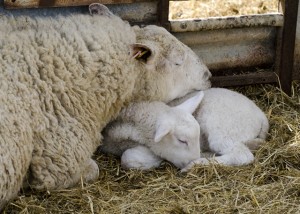Sheep Diseases
Cryptosporidiosis in Lambs
Cryptosporidium lifecycle
C. parvum has a rapid, direct life cycle and infection occurs when viable oocysts in the environment are ingested by susceptible hosts, usually young stock under a month old.
- The oocysts excyst (break open) in the gut releasing four infective parasites (sporozoites)
- The sporozoites penetrate the cells lining the small intestine and develop just below the cell membrane
- Here the parasites undergo at least two stages of asexual reproduction, then differentiate into sexual forms, which fuse to form oocysts
- The oocysts mature on the gut wall and are shed in the feces as fully developed, infective oocysts
- Cryptosporidium oocysts are infective as soon as they pass into the environment and infection soon reaches a high level and spreads very rapidly.
The primary route of infection is by direct animal-to-animal fecal-oral route. In lambs infections appears to be age related with seasonal peaks of disease reported to coincide with birth peaks in spring and autumn (Taylor et al., 2007). Although outbreaks in lambs are sporadic, mortality can be high. C. parvum is not host-specific and is in fact the second most common cause of diarrhea in calves in the United Kingdom. Therefore it is conceivable an environment contaminated with oocysts during an outbreak in calves can cause infection in lambs using the same premises or grazing area.
Lambs as young as 3 days old can be affected. Lambs are depressed and reluctant to suck while the diarrhea lasts. Very young lambs soon become dehydrated and die. In poor weather conditions lambs may die of hypothermia. The illness may last for up to 10 days, and relapses after apparent recovery are common (Angus et al., 1982).

Cryptosporidium oocysts are extremely resilient. Providing ample clean bedding, and disposing of used bedding should help minimize the risk of infection.
Control and Prevention of Cryptosporidiosis in Lambs
In the face of an outbreak of cryptosporidiosis in lambs there is little that can be done other than to isolate affected stock, avoiding overcrowding or prolonged use of contaminated areas.
The tiny, fragile looking oocysts are in fact remarkably tough, and can survive in the environment for many months. Disinfection can be achieved by steam heat or by using Oo-cide (Antec International Ltd.), an ammonia-based oocysticide, which is particularly effective against Cryptosporidium oocysts (Blewitt and Angus, 1991).
Treating Cryptosporidiosis in Lambs
As no specific ovine treatment measures are available at present, only the symptoms can be treated, by keeping lambs warm and giving rehydration therapy. However, in some cases, it is possible to use calf treatments, such as Halocur (Halofuginone lactate) off-licence under the Veterinary Medicines Directorate cascade, speak to your veterinarian for further information.
Good Practice Based on Current Knowledge
- Provide adequate clean litter and bedding for lambs kept indoors
- Maintain high levels of hygiene through regular replenishment of bedding, and disposal/burning of used bedding
- If possible, disinfect lambing pens between ewes
- Steam clean the housing area annually following turnout to grass
- Keep feed stores secure from wildlife
- Give sick lambs supportive therapy by oral rehydration with a proprietary electrolyte solution
- Encourage the affected animal to drink by frequently offering it a small volume of electrolytes
- Protect infected neonates from chilling
Remember that cryptosporidiosis is potentially a zoonotic disease and all farm staff and visitors should follow rigorous hygiene precautions


 British English
British English

Comments are closed.